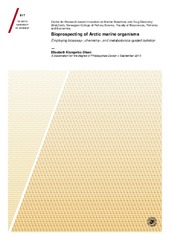| dc.contributor.advisor | Andersen, Jeanette. H. | |
| dc.contributor.author | Olsen, Elisabeth Klungerbo | |
| dc.date.accessioned | 2015-09-28T13:20:48Z | |
| dc.date.available | 2015-09-28T13:20:48Z | |
| dc.date.issued | 2015-09-25 | |
| dc.description.abstract | The marine environment inhabits a large diversity of organisms that produce natural products as a strategy for survival. Many marine natural products are found to display different bioactivities and some of them have reached the market as drugs or dietary supplements. Comprehending the great potential of bioactive marine natural products motivates for the continuing bioprospecting of organisms from the oceans.
In this thesis the aim was to isolate bioactive marine natural products. Three different approaches were studied, namely bioassay-, chemistry- and metabolomics-guided isolation. The bioassay-guided isolation approach yielded an antioxidative bromophenol isolated from the alga Vertebrata lanosa, which was active in both biochemical and cellular assays. It was more potent than the known antioxidants luteolin and quercetin in both cellular assays and of quercetin in one of the assays.
Barettin was attributed an additional bioactivity as it, together with the structurally similar 8,9-dihydrobarettin, inhibited electric eel acetylcholine esterase (AChE). Inhibition by both barettins was in the range of the reported AChE inhibitors pulmonarin A and B and of the drug galanthamine. Two brominated indoles were isolated, using chemistry-guided isolation, from Geodia barretti based on their structural similarities with barettin and 8,9-dihydrobarettin. The brominated indoles were used as inspiration for synthesising a library of 22 structurally similar compounds. Synthetic compounds having a combination of a bromine substituent in a specific structural position and a positively charged amine were the most potent. However, the brominated indole was found not to be sufficient for AChE inhibition.
Metabolomics-guided isolation was used to study the differences in natural products produced by the closely related sponges G. barretti and G. macandrewii. Employing this bioprospecting approach a novel compound unique for G. macandrewii was identified and it was suggested that metabolomics could be a valuable supplement to other bioprospecting approaches like the bioassay-guided isolation. | en_US |
| dc.description.doctoraltype | ph.d. | en_US |
| dc.description.popularabstract | Gjennom arbeidet mitt har jeg funnet biologisk aktive forbindelser i ulike marine organismer. En antioksidant ble isolert fra Vertebrata lanosa, også kjent som grisetangdokke. Denne antioksidanten var aktive i celle baserte assays i tillegg til biokjemiske assays. I mennesker kan oksidasjon av molekyler være skadelig og en diett som består av antioksidant-rike matvarer er kjent for å være helsebringende.
Geodia barretti er en svamp som er kjent for å produsere barettin og dihydrobarettin, som har flere bioaktiviteter. Disse to forbindelsene viste seg å hemme et enzym som bryter ned nevrotransmitteren acetylkolin. Acetylkolin er med på å overføre impulser mellom nerveceller og mellom nerveceller og muskelceller. Både økning og demping av denne nevrotransmitteren forstyrrer impulsoverføring, det er derfor viktig at nivået er regulert. For lite acetylkolin er kjent som en årsak til sykdommen Alzheimer. Ettersom de isolerte forbindelsene hemmer enzymet som bryter ned acetylcholin, vil det være interessant videre vurdere om de har en effekt ved Alzheimers.
En ny kjemisk forbindelse ble isolert fra svampen G. macandrewii, denne ser ut til å være aktiv mot kreftcelle-linjen melanoma, men også mot normale lunge fibroblaster. Ut fra dette virker det som om aktiviteten dens ikke er selektiv mot kreft. Dette arbeidet viser at marine organismer inneholder en rekke interessante bioaktive stoffer. | en_US |
| dc.description.sponsorship | MabCent-SFI, a Centre for Research-based Innovation on Marine Bioactives and Drug Discovery og UiT, the Arctic University of Norway | en_US |
| dc.identifier.isbn | 978-82-8266-104-1 | |
| dc.identifier.uri | https://hdl.handle.net/10037/8145 | |
| dc.identifier.urn | URN:NBN:no-uit_munin_7726 | |
| dc.language.iso | eng | en_US |
| dc.publisher | UiT The Arctic University of Norway | en_US |
| dc.publisher | UiT Norges arktiske universitet | en_US |
| dc.rights.accessRights | openAccess | |
| dc.rights.holder | Copyright 2015 The Author(s) | |
| dc.rights.uri | https://creativecommons.org/licenses/by-nc-sa/3.0 | en_US |
| dc.rights | Attribution-NonCommercial-ShareAlike 3.0 Unported (CC BY-NC-SA 3.0) | en_US |
| dc.subject | VDP::Teknologi: 500::Bioteknologi: 590 | en_US |
| dc.subject | VDP::Technology: 500::Biotechnology: 590 | en_US |
| dc.title | Bioprospecting of Arctic marine organisms
Employing bioassay-, chemistry-, and metabolomics-guided isolation | en_US |
| dc.type | Doctoral thesis | en_US |
| dc.type | Doktorgradsavhandling | en_US |


 English
English norsk
norsk



